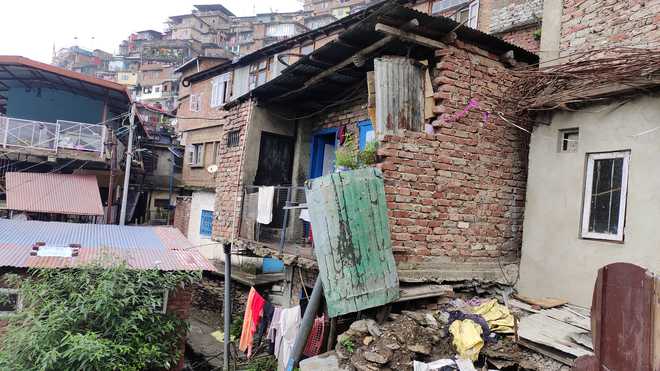Bhanu P Lohumi
Dark clouds coupled with lightning and thunder appearing like messengers of impending disaster haunts people in the state capital.
Landslide threat looms large over two dozen houses in Krishna Nagar locality in Shimla, as heavy monsoon rain can spell a doom for them anytime.
They are on tenterhooks and the advancement of monsoon with prediction of heavy rain by the MeT office is only adding to their anxiety.
The onset of monsoon has started sending ominous signals and these houses, perched on slopes have developed cracks. There is a potential threat to these houses collapsing in case it rains heavily, triggering a massive landslide.
Krishna Nagar is situated below the Circular Road near the main gurdwara and all drains from the Mall Road, Middle Bazaar, Lower Bazaar and Ram Bazaar culminate here. The hill stratum has become porous due to seepage and is vulnerable to landslides.
The entire waste from the Mall Road and the Lower Bazaar areas flows in open drains in this area. During the rainy season, the water level is so high that drains overflow and many a times these are choked and dirty water enters the houses of people.
The population of Krishna Nagar is over 5,000. The houses constructed are untenable because of the poor quality of construction on steep slope with high risk of sliding. This area houses a large number of unauthorised and kutchha houses, which have been declared unsafe, but due to their poor financial condition, these people are unable to move to safer places and continue living here.
“The area faced similar threat in 2013 also and several houses were damaged and endangered due to landslide and the construction of retaining wall was started, but the work was left unfinished as the municipal authorities maintained that drains and nullahs needed to be repaired first,” said Madan Lal, a resident of house No 124.
“We repaired our houses after 2013, but the situation is back to square one after rains due to the callous approach of the administration,” he said.
It was a scary site, when The Tribune team entered the house of Sunita, as her daughter was sleeping with cracks all around the walls. “We are living under grave threat, as the walls of our house have developed cracks and heavy rain can spell doom, but the administration is not heeding to our requests to construct the retaining wall,” said Sunita Devi.
“The absence of proper drainage system is the main cause of seepage, but the administration has neither maintained drains properly nor constructed the retaining walls, which has aggravated the threat of major landslide, which can be catastrophic,” says Shama, another resident.
Contractor Durgesh, who is carrying out construction work in Krishna Nagar, said: “The work is in progress, but was disrupted due to rain and would be resumed in a couple of days. Besides the retaining walls and a pathway has to be built as well.”
Bittu Kumar, councillor of Krishna Nagar ward, said: “As many as 200 families were left homeless in a massive landslide in 2013, but the government constructed only eight sheds. A number of families left the locality, while some, who were in government jobs, shifted to government accommodation and the remaining affected families are staying with their relatives.
“I have written to the Commissioner, Shimla Municipal Corporation to clean and repair nullahs as the debris of all nullahs of the main city flows down to Krishna Nagar. Last year also, water entered houses that are facing a threat,” he said.
Geophysical factors to blame
Heavy rain triggering landslides is both a natural and anthropogenic phenomena, but the landslide activity in hilly areas like Shimla is accentuated by geophysical factors such as steepness of slopes and saturation by heavy rain, melting of snow, rock vibrations, excess load from embankments, landfills and waste and debris dumps. The frequency of manmade landslides has increased due to massive construction on landslide-prone and sinking areas. The state capital Shimla is also sinking at several places due to digging of slopes for construction and infrastructure development. As per the report of the Government of India on Spatial Distribution and Concentration of Landslides released in 2003, nearly 97.42 per cent of the total geographical area of Himachal is prone to landslide hazard. Over 14 per cent and 70 per cent area is liable to severe to very high and high risk of landslides.
Unlock Exclusive Insights with The Tribune Premium
Take your experience further with Premium access.
Thought-provoking Opinions, Expert Analysis, In-depth Insights and other Member Only Benefits
Already a Member? Sign In Now










